Norway
I told my buddy “Hey, we’re in Norway.” He said “No way.” I said “No. Norway.” He said “Who’s on first… Awe. Gotcha man! That one never gets old…
So, we saw ourselves a bit of Aurora Borealis action last night as we approached the country of Norway. Not as brilliant as others that we’ve seen, but worth getting up for.
We arrived in Norway on Monday, August 12. Norway is a country of 5.5 million, best known for its snow capped mountains, rugged forests, and glacier-fed fjords.
Norway is known to be one of the happiest countries in the world. And why not? It is one of the few countries that you can see polar bears in the wild. And if you come in the summertime, you’ll have plenty of time to experience it all, because the sun (pretty much) does not set. (Although it’s August, and we are seeing about 5 hours of darkness each night.)
Oslo
So, we’re safe on first, in our series of visits to Norway, stopping off in the capital city of Oslo, home of the famed Oslo fjords.
Fjords is a Norwegian word, meaning “a safe place to forge a waterway”. This fjord is a long waterway leading to the city of Oslo. Its steep, scenic mountains on either side of the waterway hide an alarming history. In 1940, it was the location of the sea battle that opened WWII. This was to become known as The Battle of Drøbak Sound.
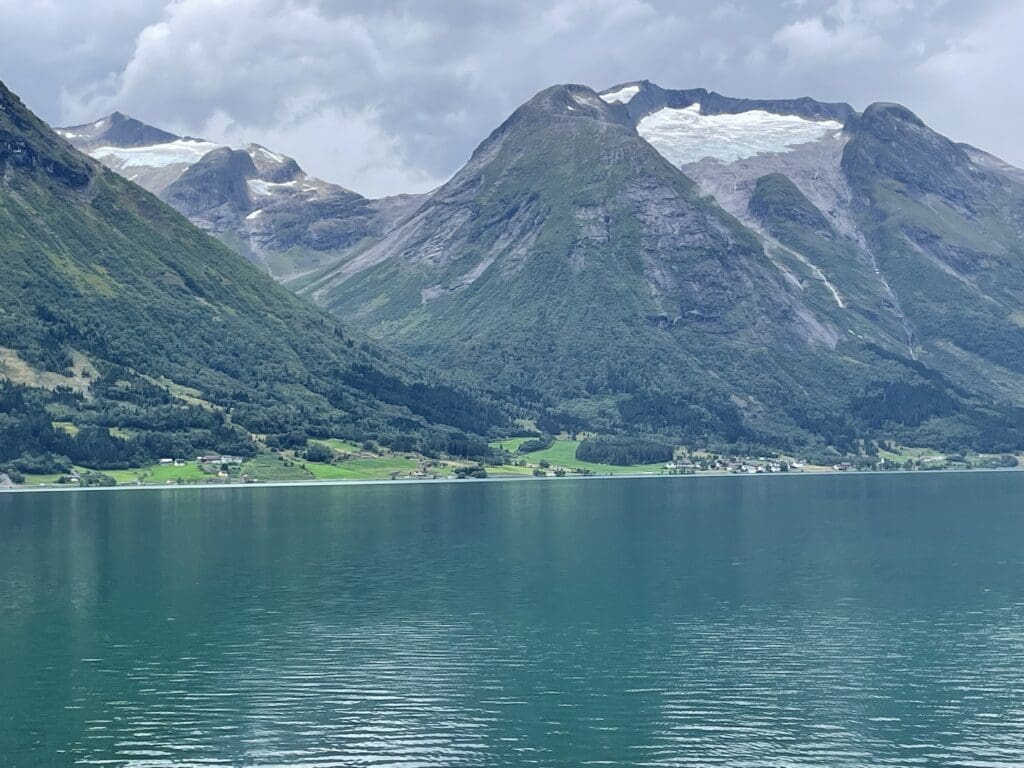
In 1940, the German had sent a flotilla of warships up the fjord to Oslo in an attempt to capture their heads of the Norwegian government. They had disregarded an old fort on a small island along the coastal waters, which had long ago been relegated to training.
However, seeing the incoming flotilla, to the German’s surprise, the Norwegian trainees lobed a shot right on the deck of the flagship as it approached, igniting an onboard munition magazine.
The flotilla was stalled, but had a three-day old battleship amongst them. As the fearsome battleship maneuvered into place to teach the pesky trainees a lesson, the Norwegian, having just finished training on the country’s new torpedo capabilities, surprised the Germans a second time, striking their brand new fancy-pants battleship twice before it could even get off a shot. Both ship sunk!
So while the endeavor did not avert the war, it did stall the German’s efforts long enough for their government to escape before the country was invaded.
Oslo
Oslo is the country’s southernmost city, and is called “the biggest little village in Norway”. It has one million residents. We toured the city before making our way back to the city center for a drink and a burger. It is a pretty big city, and we especially liked the north end of town, which is mostly farmland and countrysides. (There are more sheep in this country than there are people!)
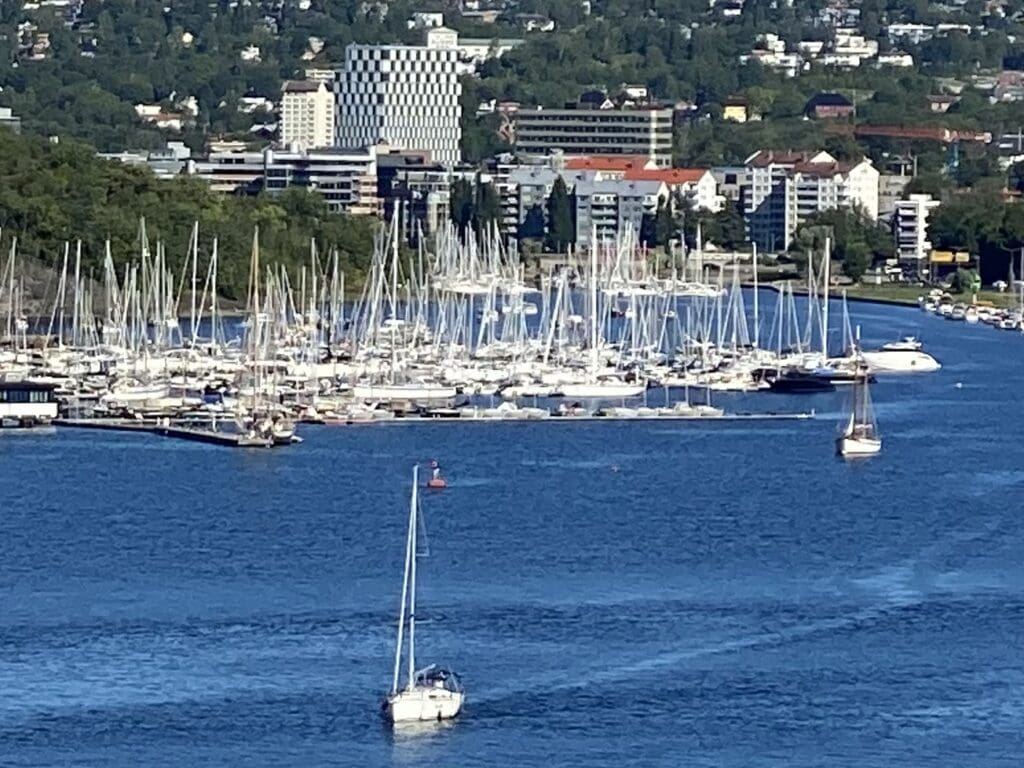
Sheep are very popular here, and in the country, they are everywhere. Also, most all of the (really warm and colorful) Norwegian clothing is made of sheep wool.
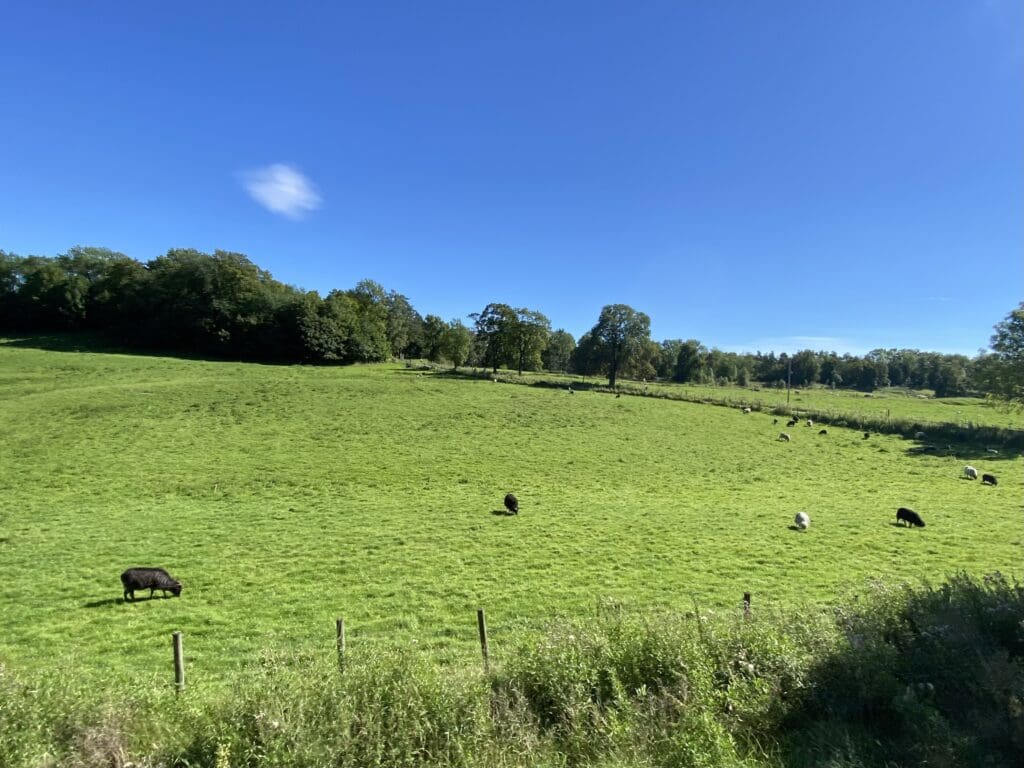
Like Denmark, this country it is super energy efficient, and bicycle friendly. For those not walking or riding, almost exclusively, electric cars and trains (trolleys) are used for transport. If you find yourself walking, watch out for bicyclist, who appear to barely hide their disdain for pedestrians walking on their bike paths that double as sidewalks. (Happiest city in the world, except for the aggressive bicycle riders I guess…)
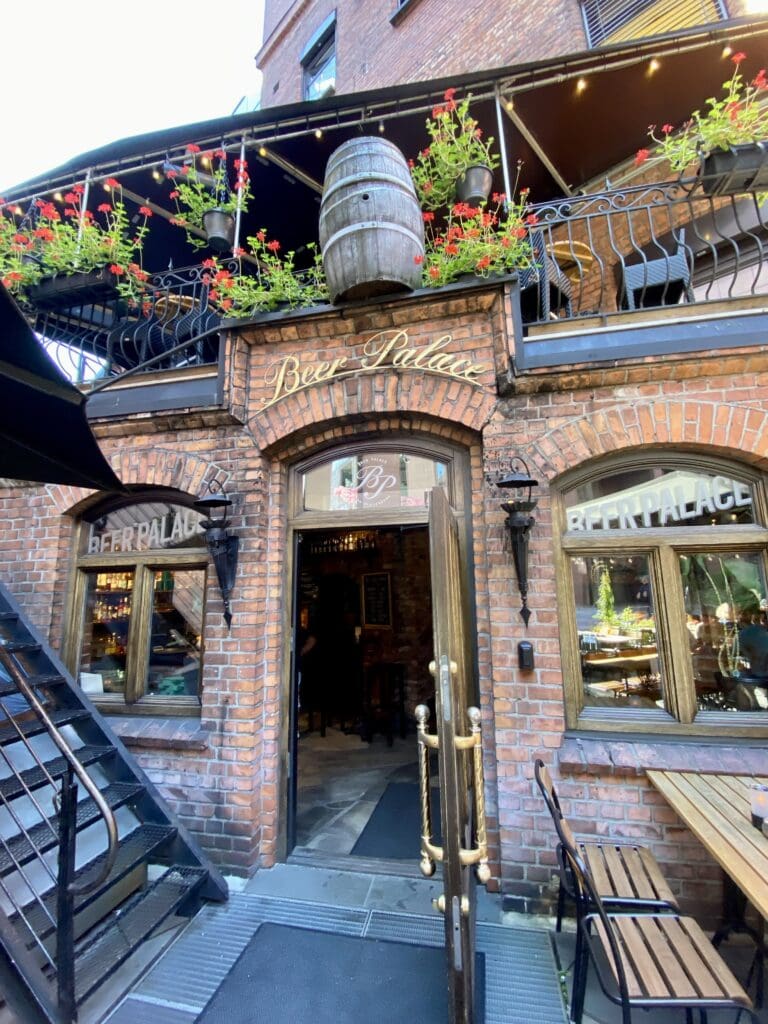
Like Denmark and other recent cities, if you are on open air buses, they close their second story roofs (for safety) while in parts of the city where the trains have their overhead power lines. Unlike other recent cities, the roofs remained closed at all times here, because the entire city is powered by electric trains. (Good for them.) Many of these look more like trolleys than trains, so it is kinda cool.
Their Viking history reins supreme here. Lots of folklore. We especially like the stories about trolls. And I have to say, I believe amigos. Trolls and Viking are the real deal. Great, great legends…
In the tradition of Vikings, all of the churches are built from wood. Even the new churches. (It’s kinda cool that we even notice such things now. Only 50-some countries, and we finally got a bit of a clue.)
😉
Speaking of legends, two friends that we have made along the way are a couple from Tulsa, Michael and Susan. Michael is a retired aircraft mechanic. Really nice salt-of-the-earth folks.
So last night, Susan was playing the slot machines in the ship’s casino, and she won $20,000. Wahoo! Go for her. To celebrate, Michael purchased this really cool knife. I had seen them earlier in the day at some random shop along the way. These were extremely large strait-knife on a stone display stand. The handle is made out of Woolly Mammoth tusk, and the place is this matte black Damascus Steel that has a colorful oil on water shimmer to it. Very Viking-like.
That got us to talking about where the heck you get a Woolly Mammoth tusk from. The knife maker told Michael that, in Northern Siberia, Russian’s use hydraulic mining techniques, blasting the entire sides of permafrost mountains down with pressurized water, to expose the skeletons. This peaked my interest, but I could not find anything about this online. I did find an interesting article though about how the Russians harvest the skeletons. Anyway, we are very happy for our legendary friends.
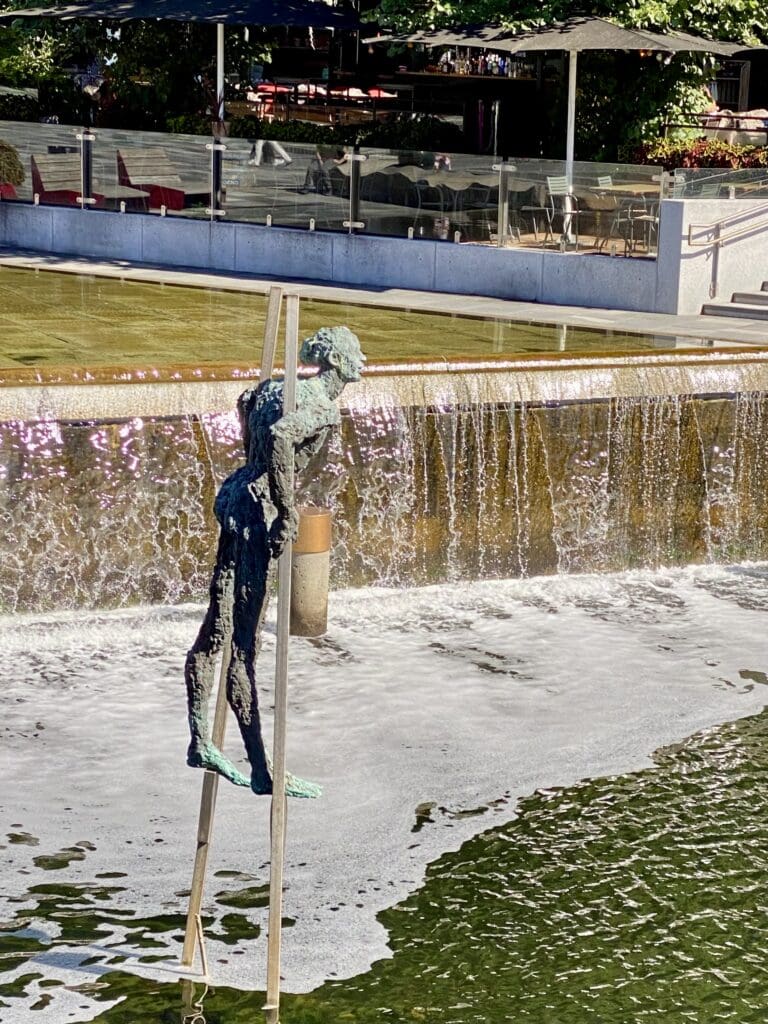
We enjoyed a horse carriage ride in Oslo. Very cool. Afterwards, we took a city tour that was very informative, and eventual found a cozy pub for a few beers and a burger. Very nice day.
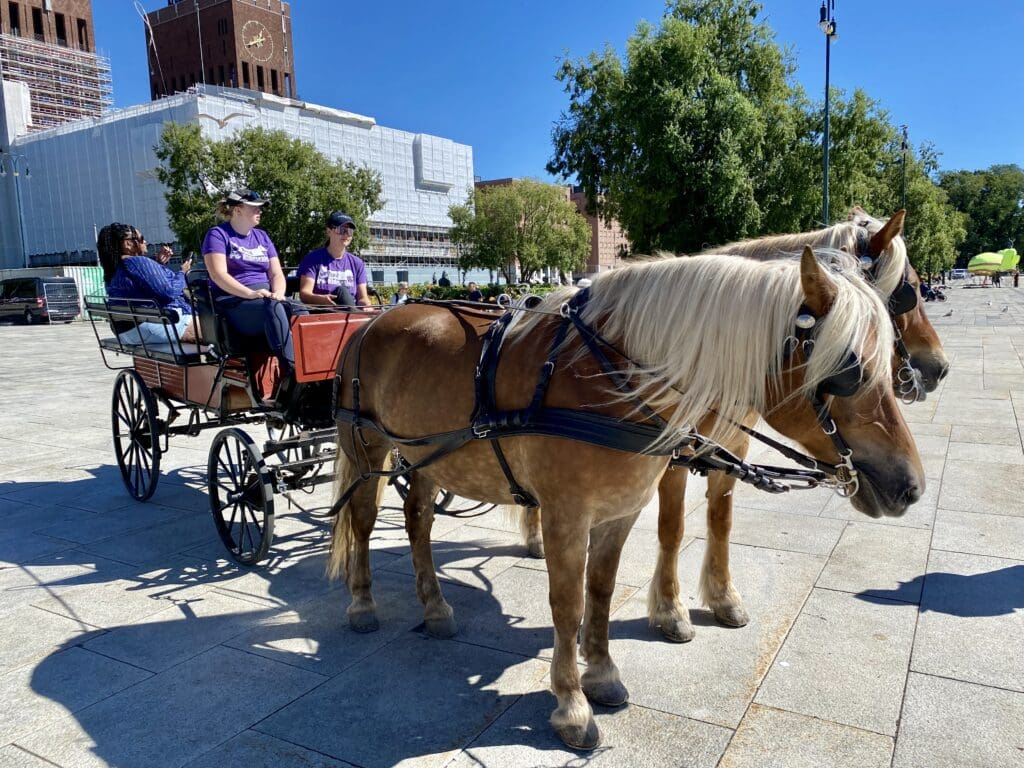
Kristiansand
On our second day in Norway, we explored the small town of Kristiansand. The town’s 60,000 residents are able to take advantage of the fact that this is the warmest places in the country. It gets little snow, and rarely has freezing temperatures.
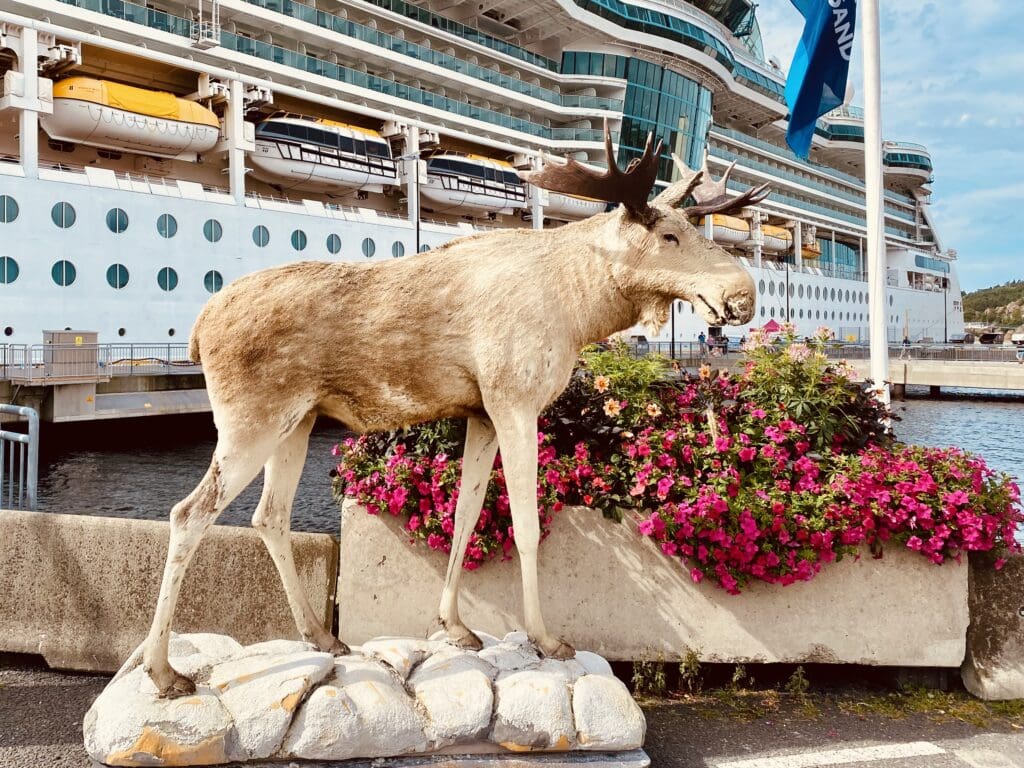
The town itself is very small. It’s Neo-Gothic cathedral and the local zoo are pretty much the only site in town, but the homes and businesses have a cute architecture, and there is many outdoor advenures here. So much so, that the town and its surrounding areas are often referred to as the country’s “outdoor playground”.
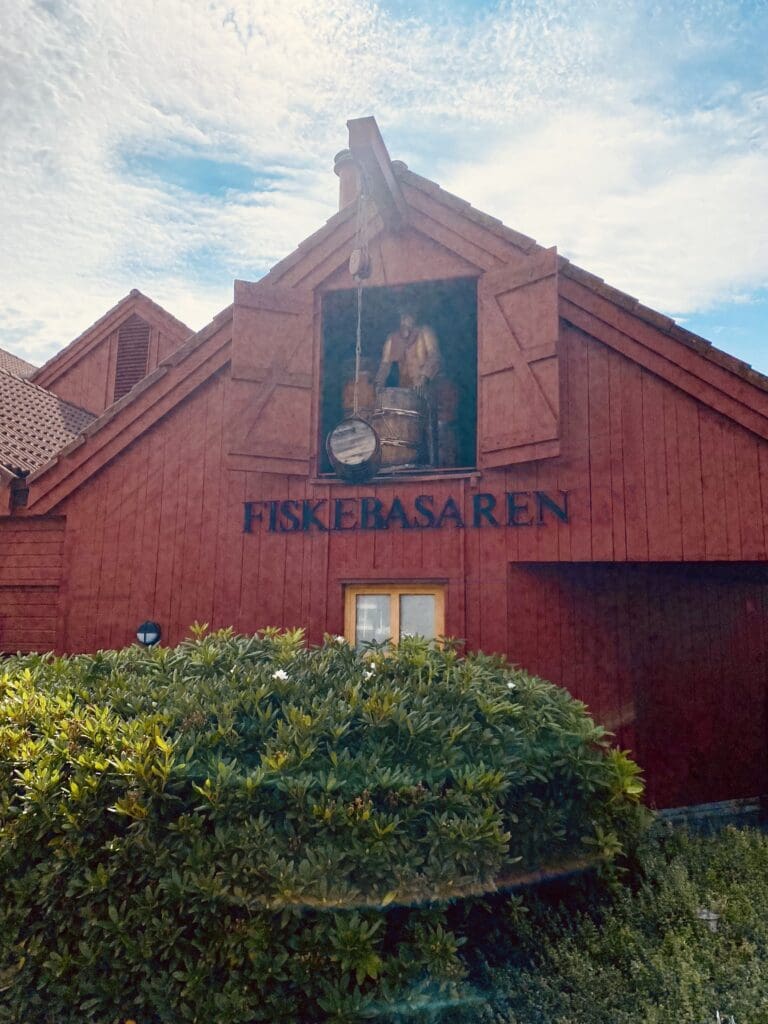
I enjoyed walking the town, and visiting with friends along the way. Very quaint little place.
I was very fond of the town’s laid back semblance, which reminded me of a fall day in a small Maine seaport town visited in days gone by.
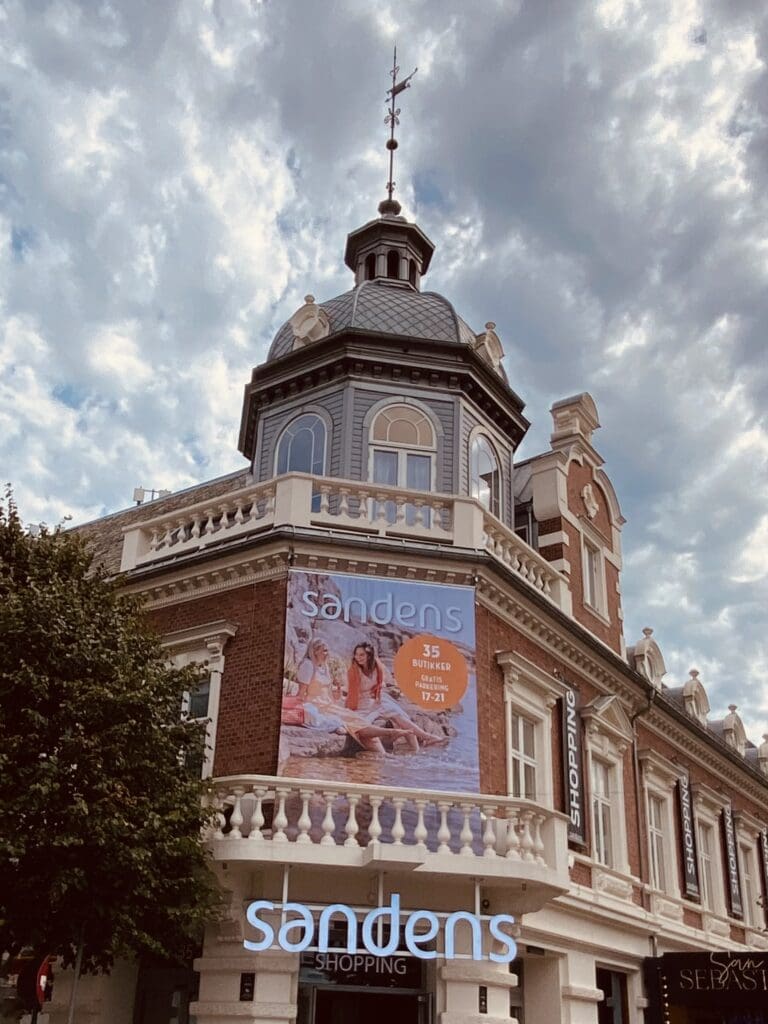
So we are nearing the end of 17 consecutive days of back-to-back activities, and it was kind of nice to cut the day short today and enjoy an afternoon movie. My wife and both my knees thanked me.

I took a picture of the ship today, and noticed one of the ropes used to tie it down did not have a Rat Guard on it. These are big round metal disks that are mounted on the ropes over the water. If a rat tries to walk along the rope to stowaway in a ship, it can’t get around the steel disk and ends up falling in the water. (You can see that the two ropes in the right have them, way up towards the top of the rope, but the one on the right doesn’t. “Lucy. You got some ‘spraining to do!”
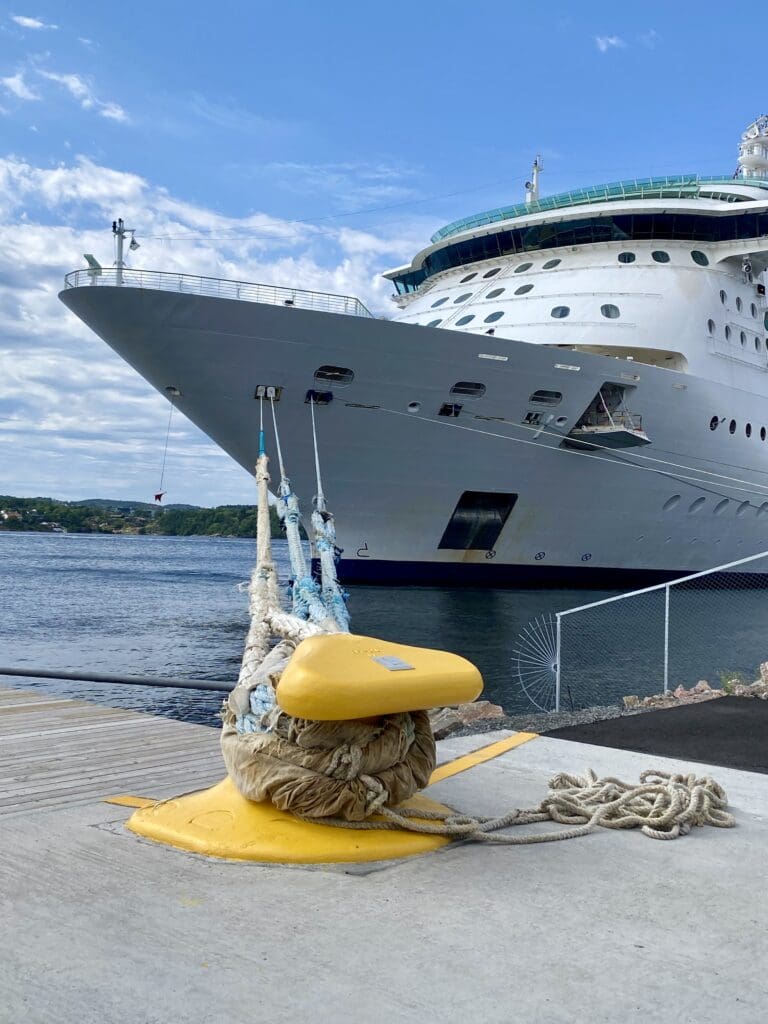
Haugesund
On Wednesday we awoke in Haugezsund (pronounced hau · guh · sun) population 35,000.
Formerly a cannery town, the town reminded me of cannery row in Monterey, California. Haugesund was formerly the home to several Viking Kings, including a gentleman by the name of Harald Fairhair, who in 900 AD, united the Vikings, forming the kingdom of Norway.
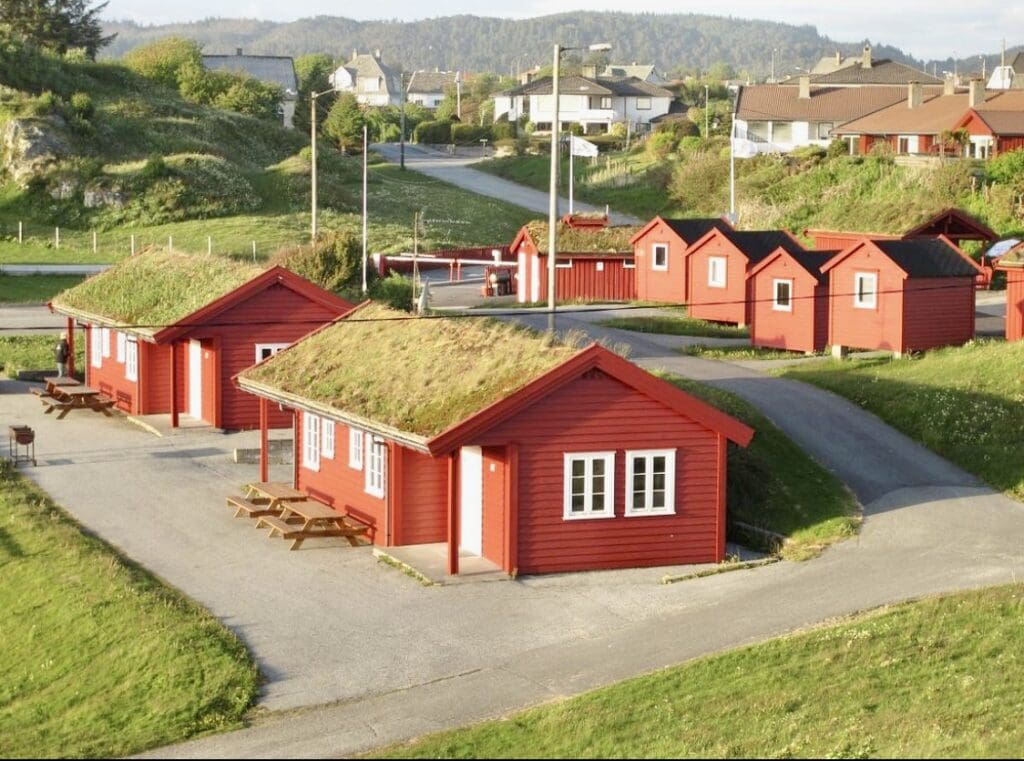
Just off of the coast lies our destination. The island of Karmøy. The island is home to Avaldsnes, a living museum featuring a reconstructed Viking village.
But as luck would have it, it was a rainy day, that stretched out the whole day. So we cut our visit short and took advantage of the situation, spending the afternoon at the ship’s (indoor) pool instead. Very relaxing.
Olden
On Thursday, we awoke several hours early to enjoy coffee on our balcony as we sailed into the village of Olden, a.k.a. “The Gateway to the Glaciers.” And what a site.
The fjords at sunrise were remarkable. And I can tell you with 100% certainty, I will always “remember the Olden days”.
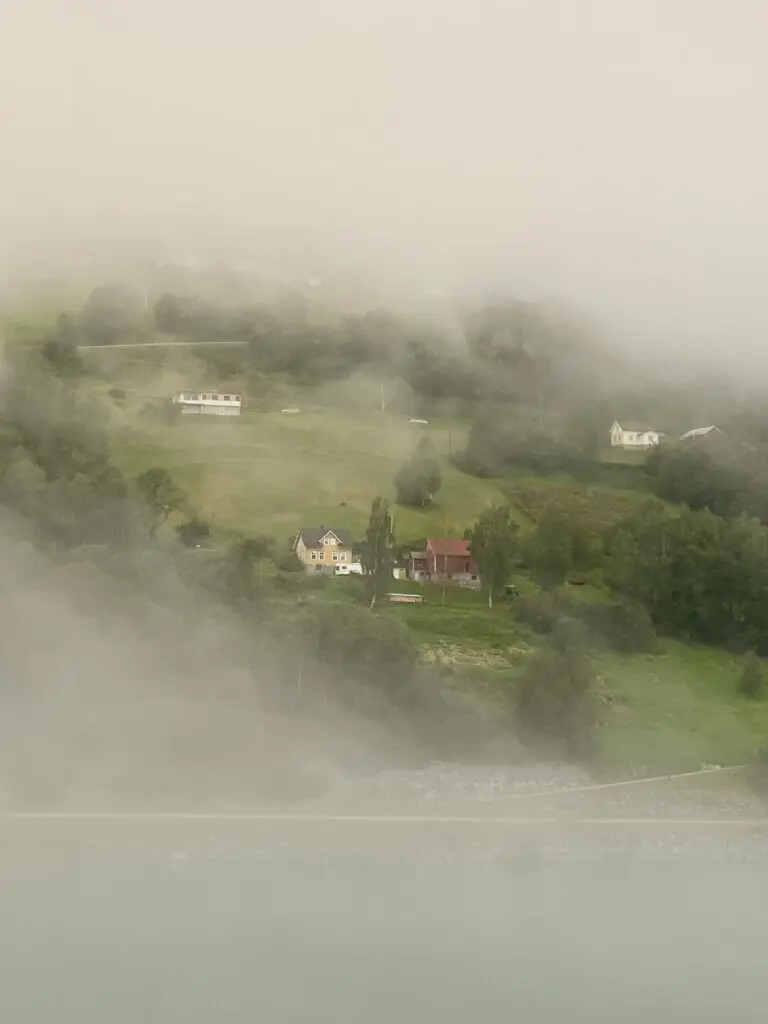
Olden is a small village, Bailey bigger than a hamlet really. Only 450 people live here, but if feels a little bigger than that.
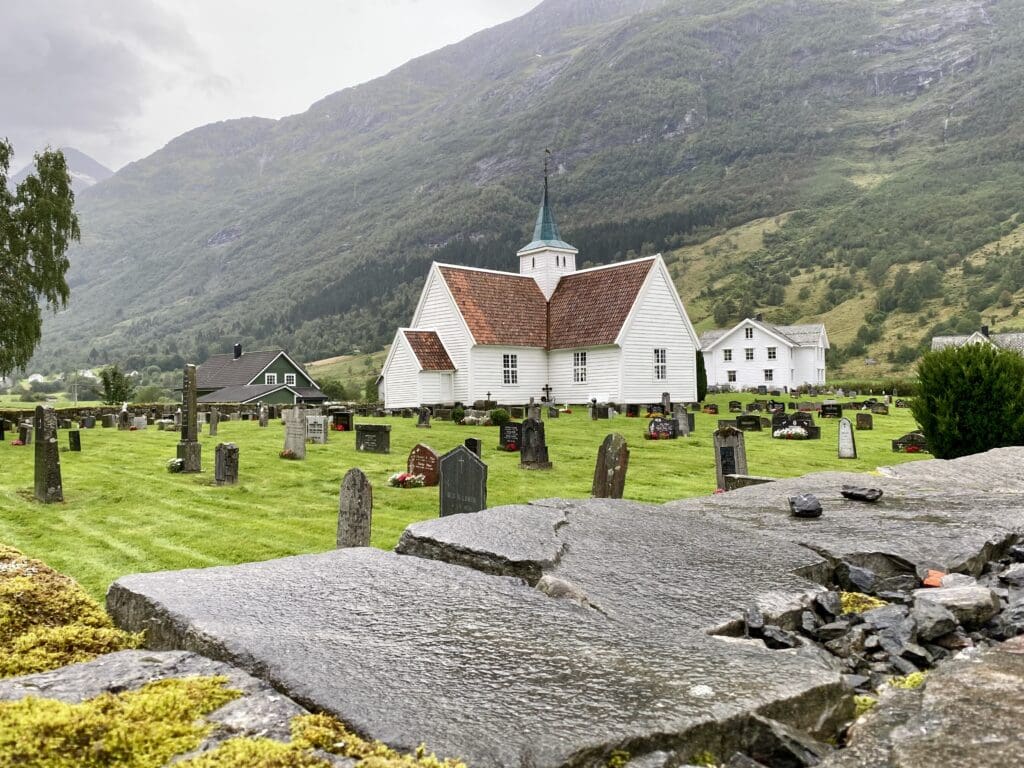
When you get off of the ship, you can literally walk to the glacier. It’s a 40 minute walk on a paved trail.
But our excursion took us elsewhere, up the mountain to the scenic Lake Stryn in Norway’s Jostedalsbreen National Park.
Olden, and the nearby town of Lowel have 1,000 residents, but they cater to over 500,000 cruise ship tourist each year. However, pretty much everything is geared towards excursion geared towards outdoor adventures. (Not many restaurants or architecture here.)
Pretty much on any day, the two or so cruise ships that visit these two villages have more guest than the total number of citizens in the whole municipality (counties) of Stryn. (There are 17 counties in the country of Norway.)
So our tour took us up a nearby mountain, with glacier-fed waterfalls feeding a large river along the mountain road. We stopped along the way to enjoy some photo ops and to hear stories about the little communities.
We especially like one group of beautiful buildings. Painted deep maroon with a dark yellow trim, the Styrneelva is a private B&B featuring several buildings containing luxurious rooms along the river. It has hosted many celebrities and even the King, who spend their days salmon fishing the whitewaters.
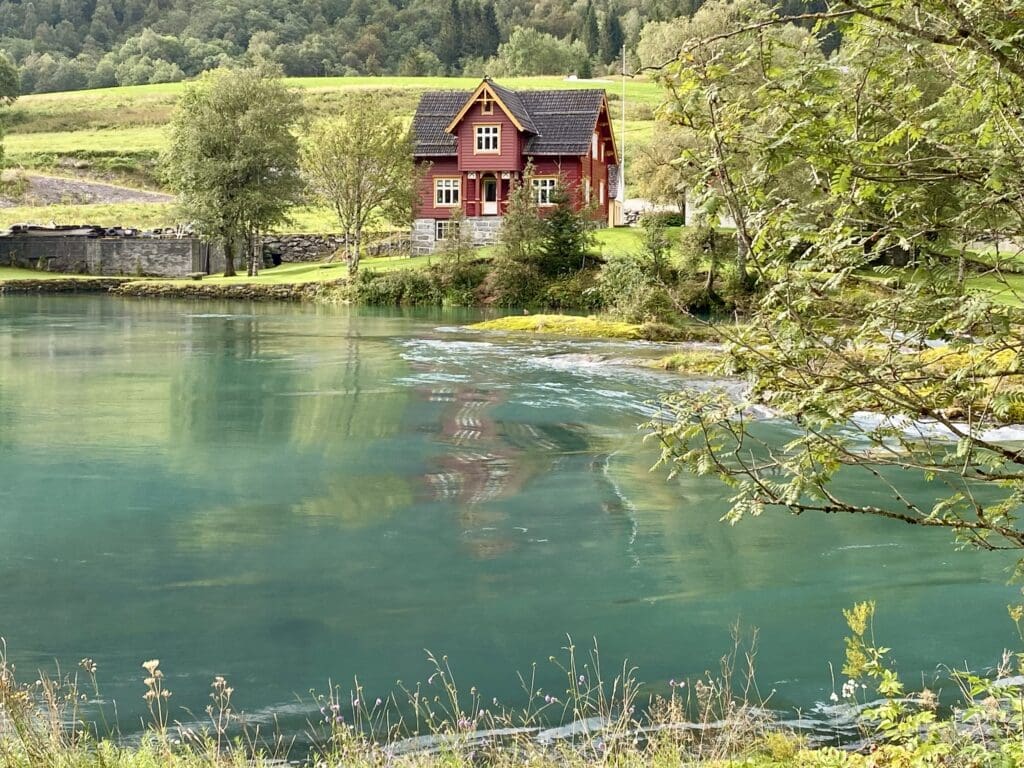
Of course, at the top of the mountain is a glacier. While only standing just below 7,000 feet, the Jostedalsbreen Glacier is the largest glacier in the European mainland. At 188 square miles, it is bigger than the country of Endora.
Receiving snowfall 12 months a year, the glacier receives 25 feet of snow each year. It also revived rain almost every Dahl that it is not snowing. While this moisture provides most of the water feeding the countless waterfalls, the Glacier is receding at a rate of 500 feet per year. This feeds the waterfalls and rivers that feed the lake below. These waterfalls carry enough water each year to meet the entire country’s water usage for 100 years.
There are 3,000 glaciers in Norway, but what is unique about this area is that one can ski here all year round.
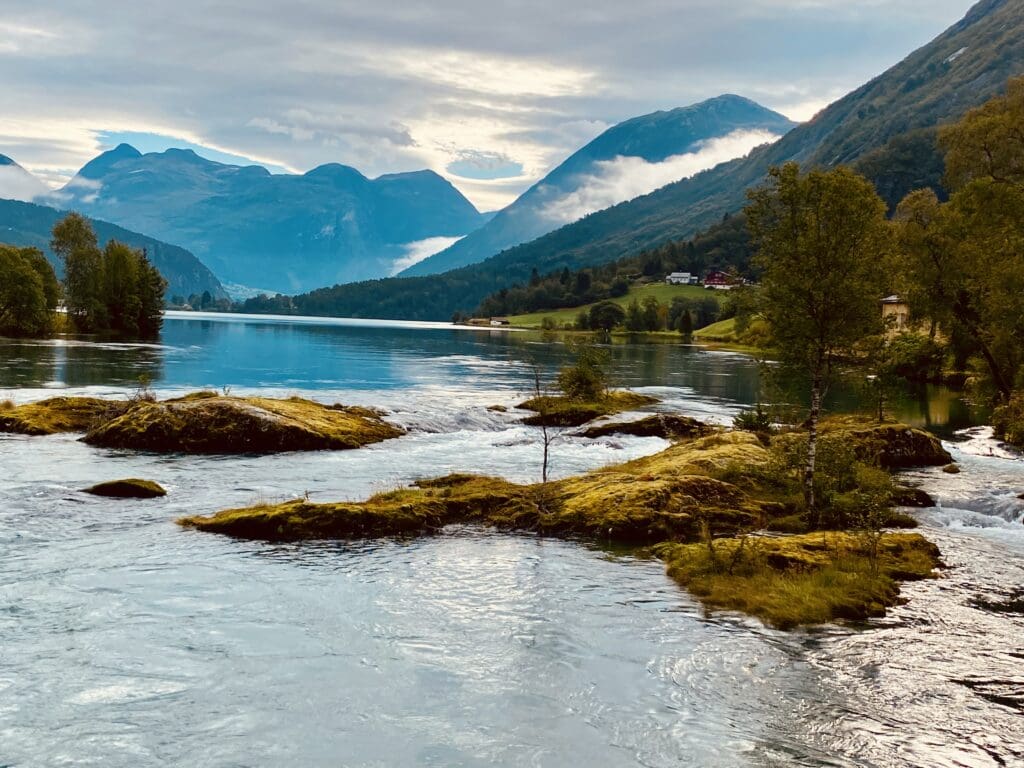
We really liked the many houses with grass roofs. These traditional farmhouse roofs are created using peeled birch barks treated with a sap-based liquids which acts as a sealant.

After drying and placing the bark on the roof, the bark would fly away unless it was weighted down, so several feet of dirt is added. The dirt is seeded to keep it from washing away. Generally the seeds of wild huckleberries are used, and for the first five years or so, the children are able to climb up several times each year to pick the berries.
After five years, nature takes over, and wild plants and even trees take over the roofs. It is rumored that from time to time, farmers have even been able to climb up and cut their family a Christmas tree. (This sounds a little far fetched, but it makes for a good story.)
We also learned about traditional Viking houses. These tended to be very long and-frame life structures. About half of the structure was used as a barn for there livestock. The other half included compartmentalized areas for there pantry, sevenths, and on the end, the family living area.
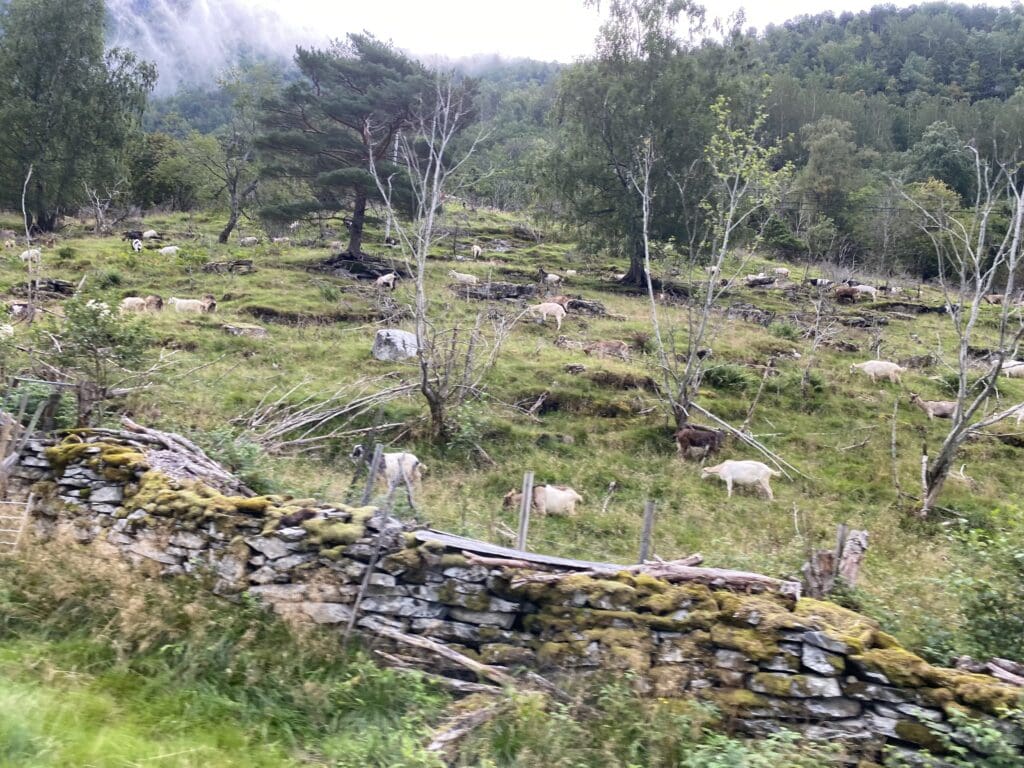
Attending public schools between 16-19 is voluntary in this municipality, and a vast majority of the young people remain in the county and follow in their parent’s footsteps, working on the family farms.
Avalanches are common here. Some farming communities moved all their homes to a central place in the valley, and built up an earthen/rock wall behind the homes to minimize the likelihood of damage.
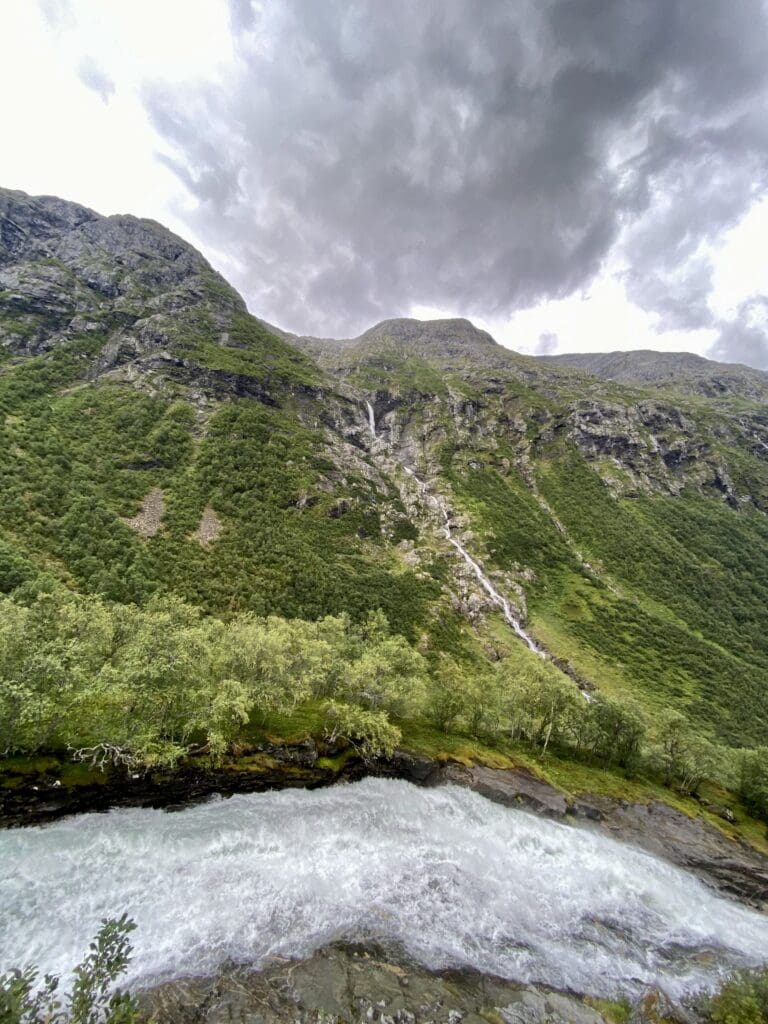
So in the “a funny thing happen ed to me on the way over here” category, the tour guide today apologized as the bus pulled away for taking so long to count all of the travelers after a short stopover to take some photos. He explained that he had once ask his bus load of travelers if anyone was missing anybody, before the bus pulled away from a quick photo-stop. He got a call 10 minutes after leaving, and had to turn around to get a fella’s wife who had been left behind. After picking her up, he ask the guy why he hasn’t spoken up earlier when he asked if wS missing, and the guy said “What can I say. I wasn’t missing her…”
😉
In the wintertime, the sun rises at 9:30, and sets at 2:30 in the afternoon. This is very convenient for the local trolls, who, legend has it, cannot come out of their caves during sunlight, or they will turn to stone.
The legends of trolls say that they are very human like, tending to be short and pudgy. They are also very ugly, with large noses and tails, and are downright mean.
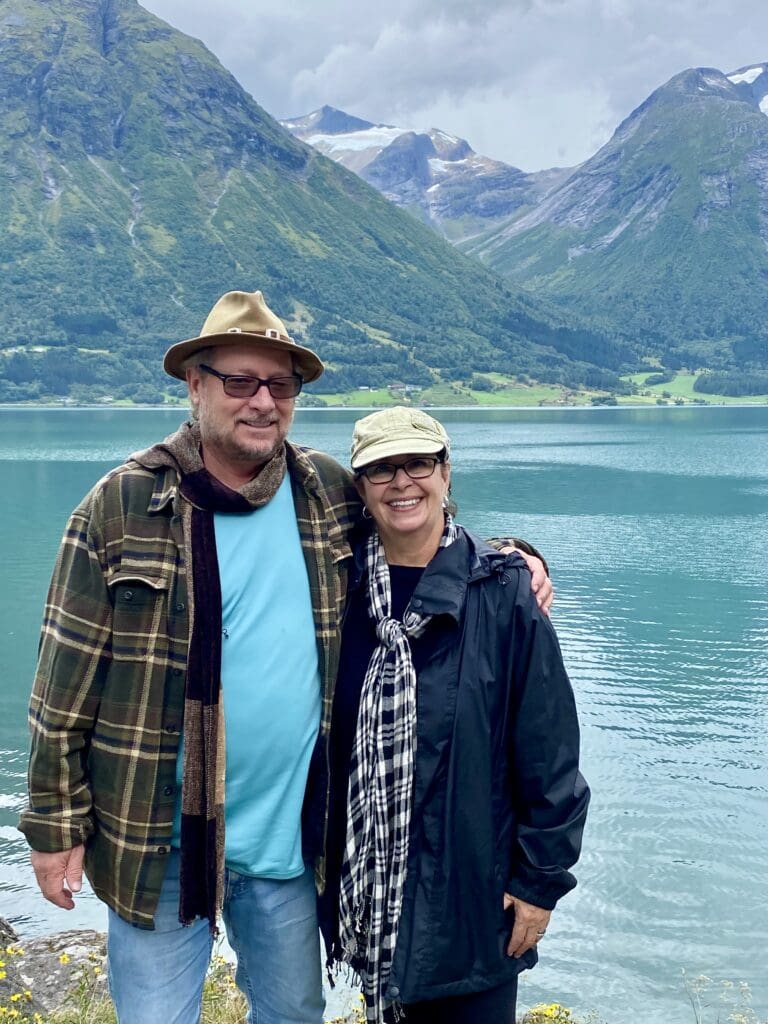
We really enjoy the troll stories in this part of the world. Lots more on this down the road, but I can say that, while Norway’s trolls live in caves, other countries claim they live in the forests or “tall grass”.
Ålesund
This mornings adventures took us to Ålesund (pronounced Ol • i • sin) a city of 50,000. We are in a part of the world where the temperature is in the 50s. A bit of a change from what we have grown accustomed to.
In 1904, a city-wide fire left the city in ruins overnight. Damaging 90% of the city, It was rebuilt in a very nice Art Nouveau architecture. This type of architecture was inspired by nature and wildlife, and rather than relying on the traditional strait edges and lines found in other architectural types, Art Nouveau embraces asymmetrical lines and repeating flowing patterns, copying the natural lines and curves found in nature. This often presents the illusion of movement.
Like most of Norway, electrical power comes from hydroelectric plants. These are dams that harness the runoff from the glaciers (which is primarily from rain and snow). These dams were built in the 60s, and provide very cheap energy. In fact, the average Norwegian drives an electric car, has all electric appliances/heating/etc. and pays only $60 a month for electricity. They joke that they pay way more each month for tollroads and ferries than they do for charging there cars.
The primary industry in Ålesund is fishing and ship building. Which dovetails nicely into discussing today’s excursions. Today we jumped on a very comfy small boat and explored a smaller fjord called the Norangsfjorden. This is a fjord that is too small for a larger ship, making this a different experience than we enjoyed yesterday.
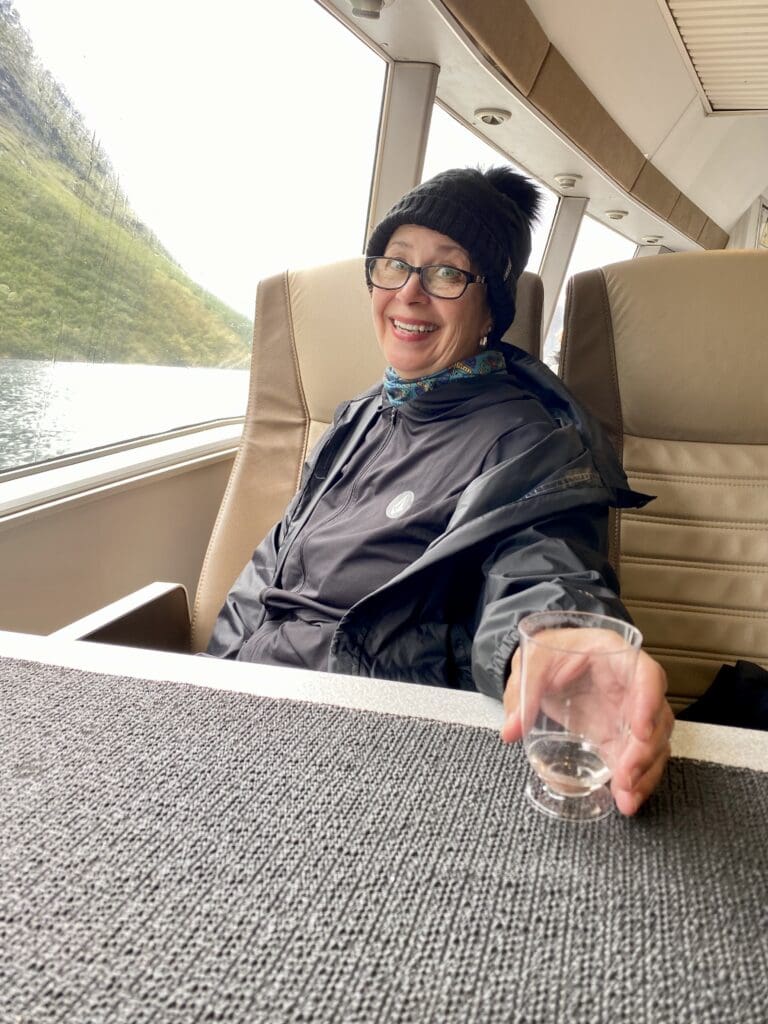
Some avalanches along the Fjords occur annually, and it is not uncommon to observe large swaths of rocky areas where vegetation does not grow.
The guide explained that, while these are considered frequent natural disaster, the worst case scenario is when an avalanche falls into a fjord with such force that it causes an “avalanche tsunami”.
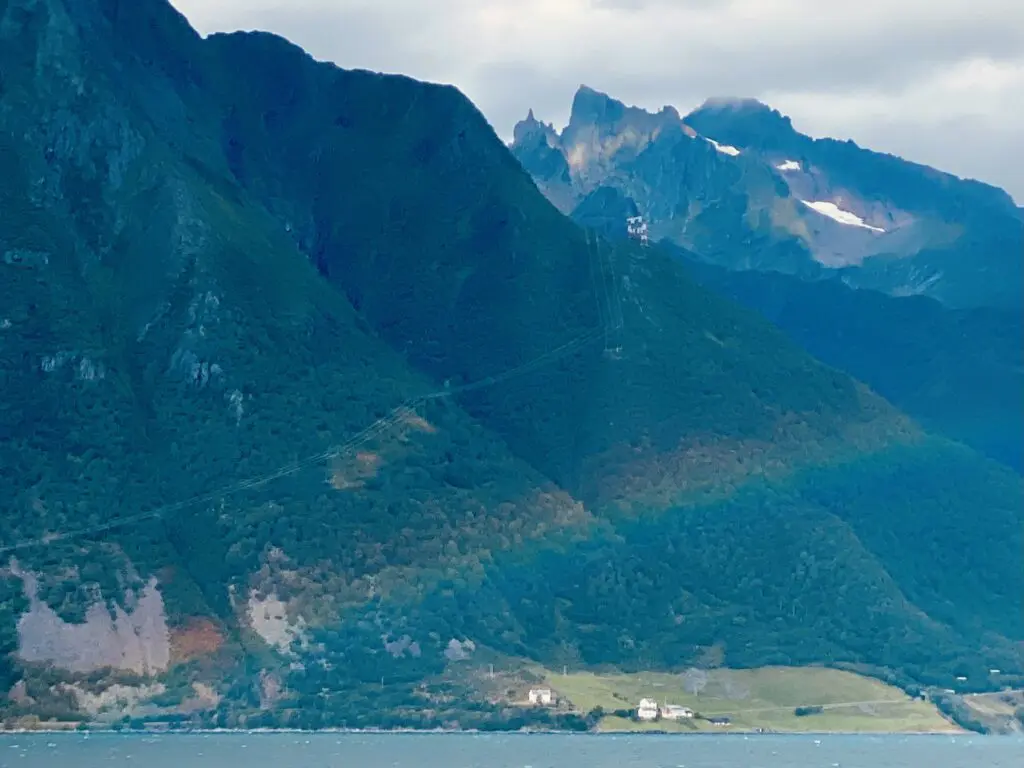
While this does not happen often, when it does happen, Norwegians are able to explain the root cause using definitive scientific logic.
These occurrences are due to one of two reasons. The guide explained that either the Viking Gods are mad at the Norwegians for this, that, or the other, or that the Trolls (who live in the mountains) are playing games the humans again. The story’s were quite lengthy and entertaining.
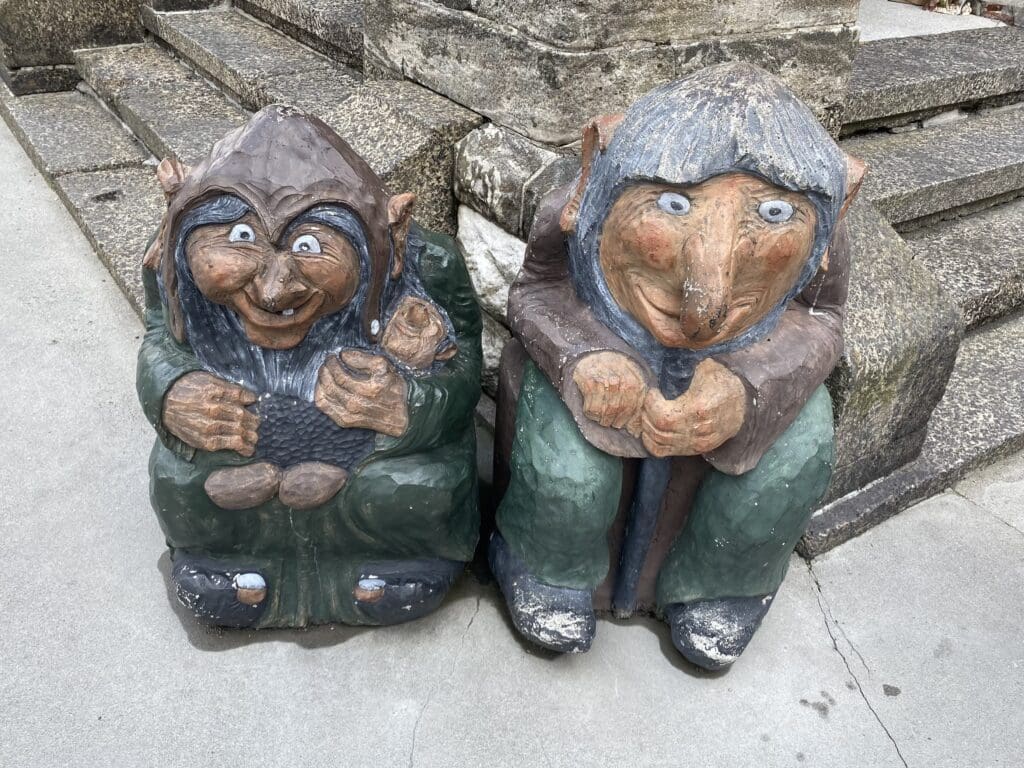
Anyway, it is common for roads to follow along the waterfront, connecting the villages. These roads are susceptible to damage from the avalanches. To address this, in the places where the roads pass below the (reoccurring) avalanche areas, the roads are either underground, or they build above ground tunnels covering them.
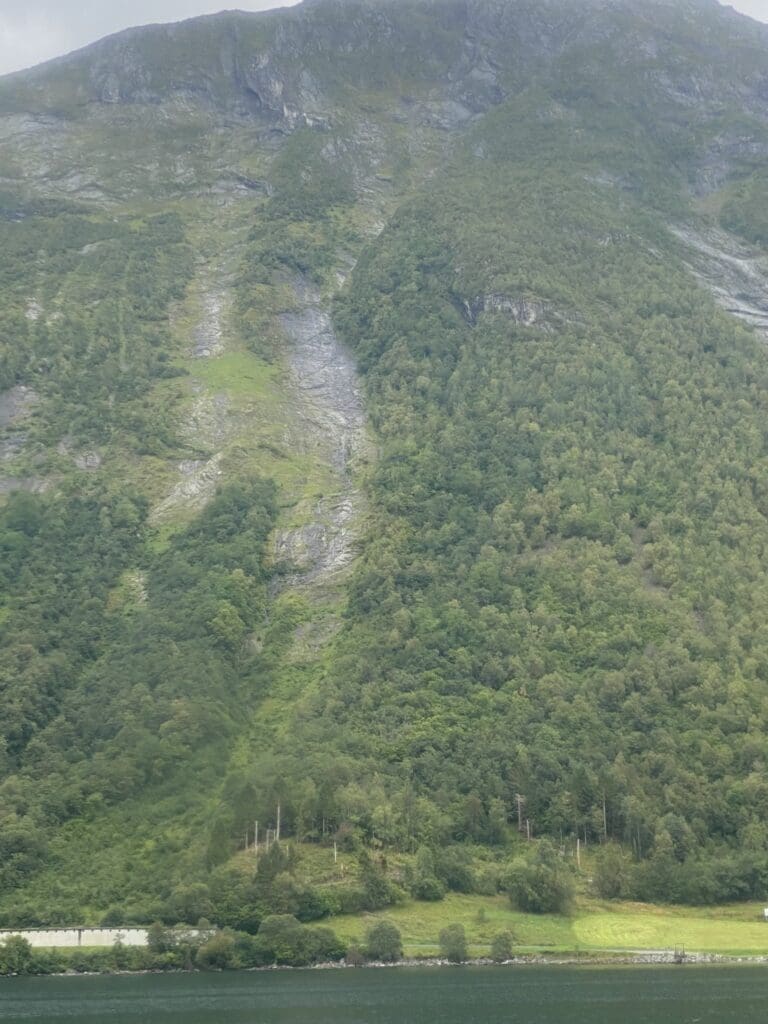
Also, we noticed many waterfront houses are right in between two areas where frequent avalanches happen. I guess after thousands of years, the patterns are pretty defined, and they are comfortable predicting the where the avalanches will fall.
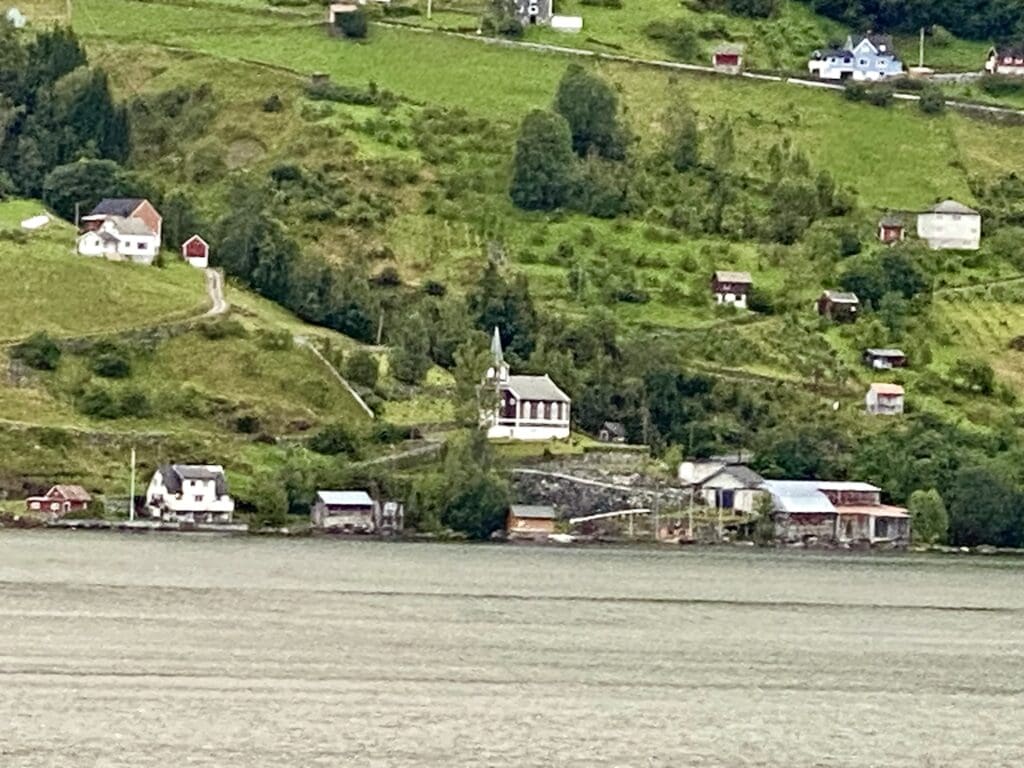
We definitely visited at the right town. There are so many waterfalls! The locals say that the summer months are called “waterfall season”.
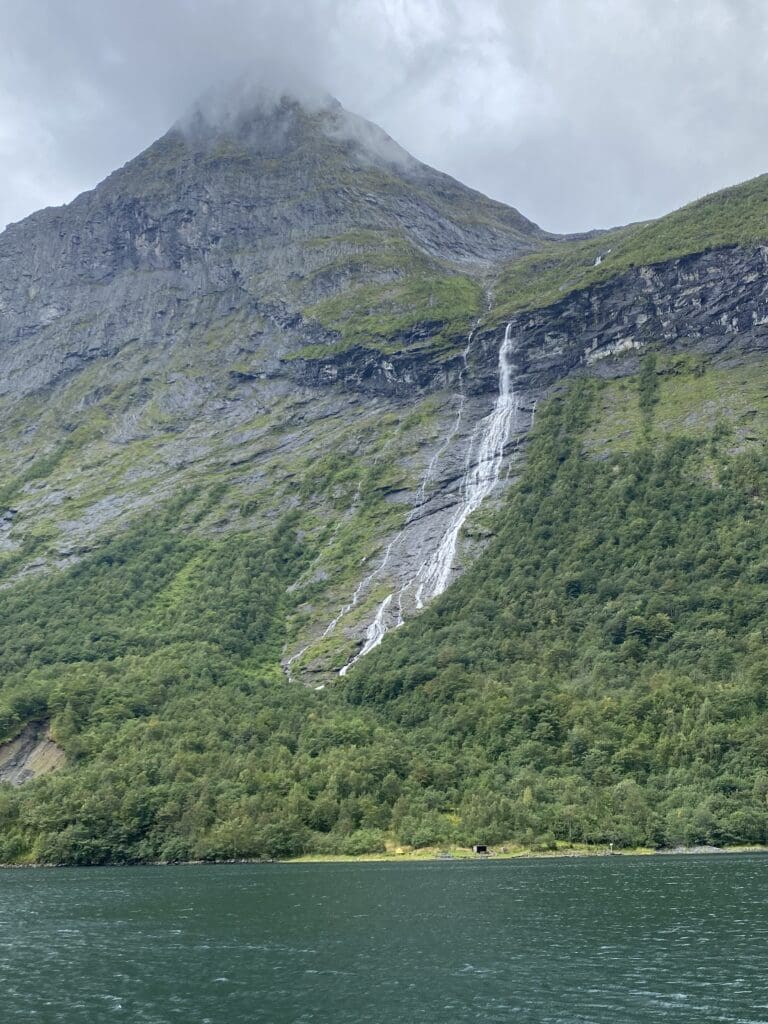
After returning to Ålesund, we spent the day exploring the city. At the direction of the guide from the fjord tour, we eventually made our way to a little pub frequented by locals. Very authentic little place. To our surprise, their menu offered pot roast tacos. Just a like mama hats make-a. Yummo!
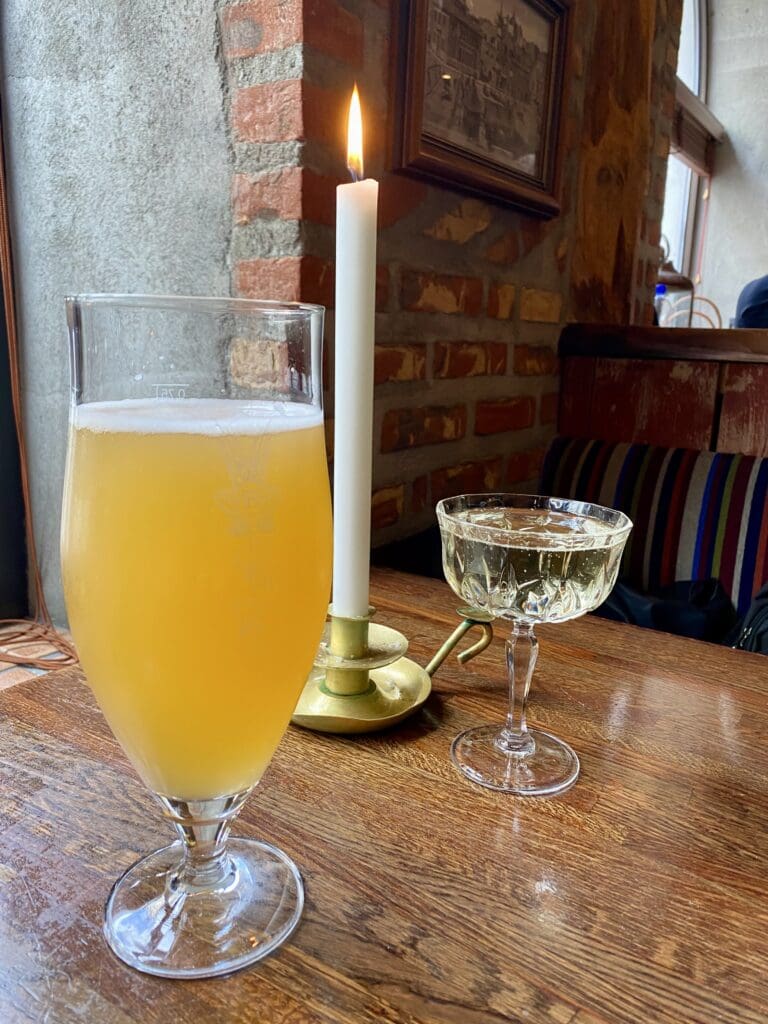
This was a great little town. Definitely would like to spend some more time here.
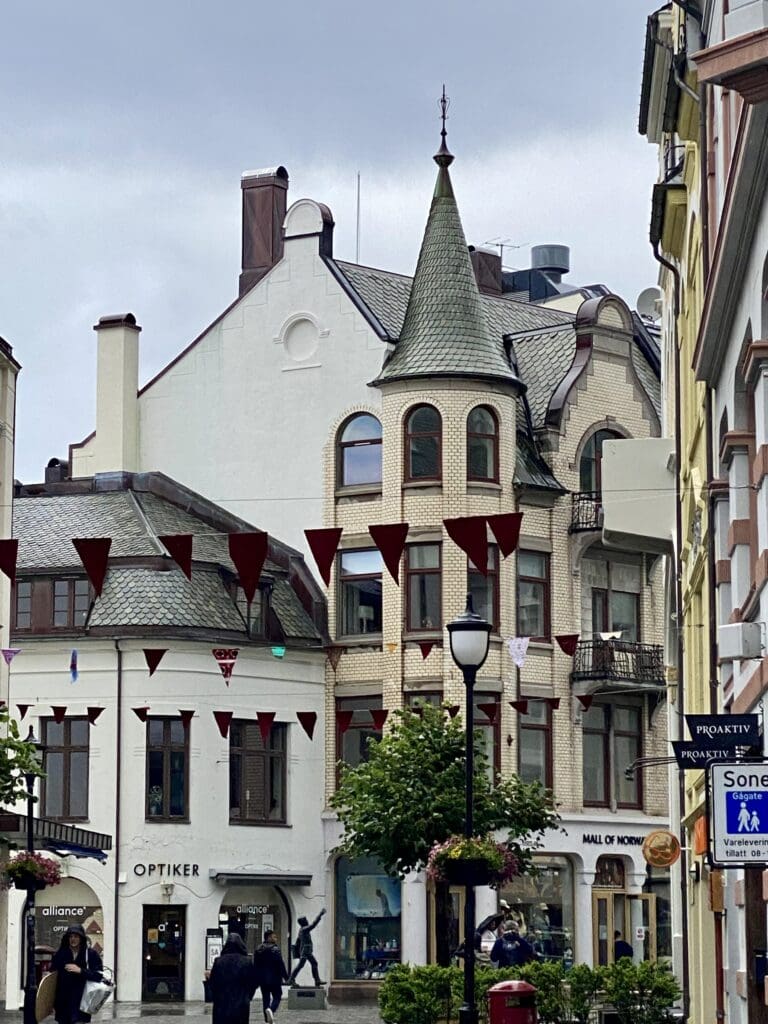
Bergen
So our final day in Norway was to be spent in Bergen, where we were looking forward to touring the colorful houses. Unfortunately, the port was canceled, and we were rerouted to spend an extra day in Amsterdam at the last minute. So we had to settle on this virtual tour instead.
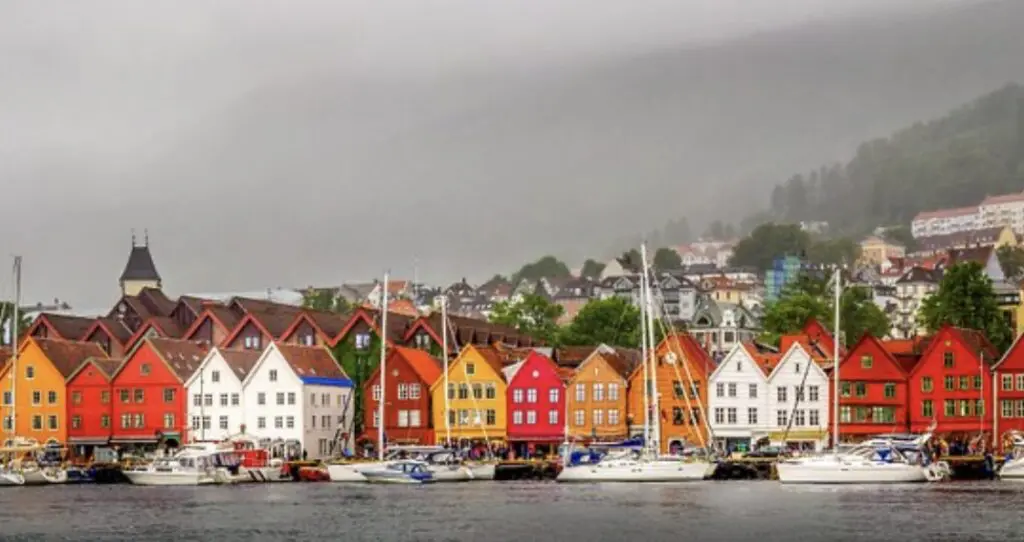
I must say, of all of the places we’ve been, the country of Norway is up near the top of the list of favorites. While it is not a haven for beachgoers.
We’ve sailed 63,000 miles since leaving home. Ms. Karen has been quite the trooper, and (in my mind) has earned a place among my favorite explorers. Christopher Columbus, Charles Lindbergh, Karen Mikus, and Neil Armstrong. There you have.
Join us in a couple of days, and we’ll share the tales of The Netherlands, home of the one and only Amsterdam.
See you then.
– Mike
“Let no man glory in the greatness of his mind, but rather keep watch o’er his wits.” – (Norse God) Odin, The Hávamál


Recent Comments